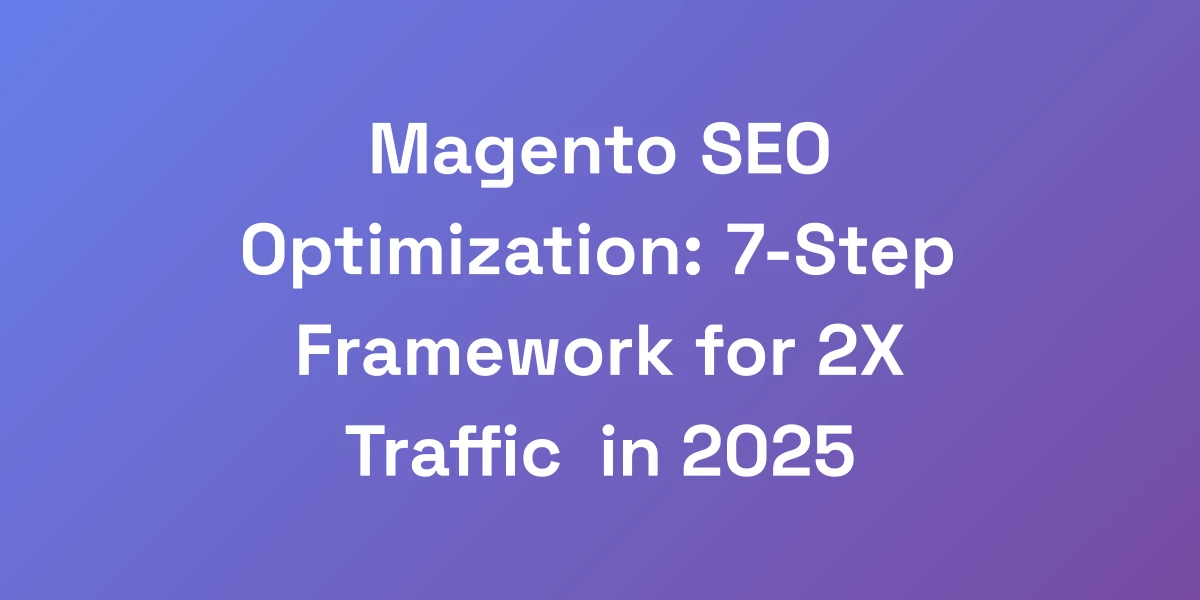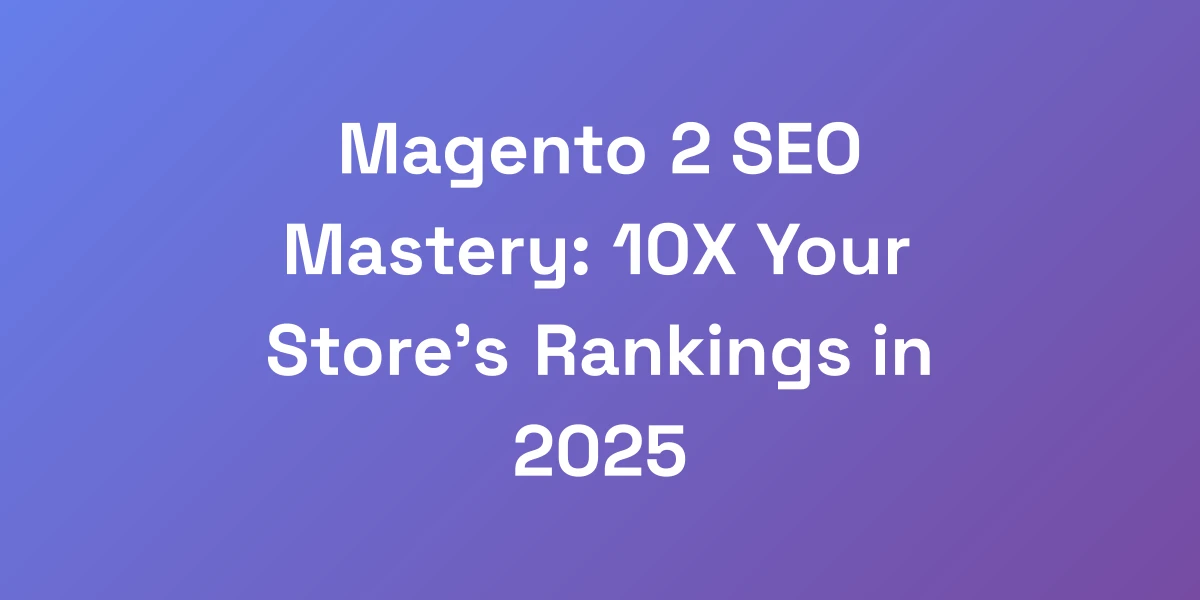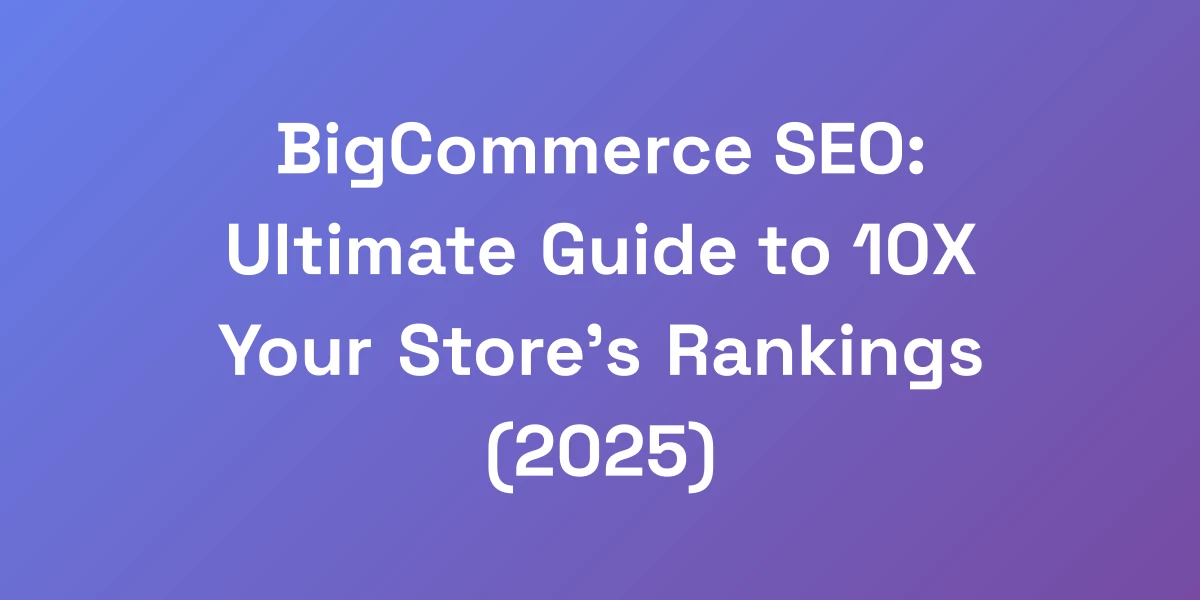
eCommerce SEO Audit: 7-Step Framework to 3X Your Store’s Traffic
Apr 6, 2025 | By [email protected]
Introduction
Ever wondered why some eCommerce stores seem to skyrocket while others barely get off the ground? We’ve been there, and it’s frustrating as hell. You pour resources into your store, optimize every nook and cranny, yet traffic remains stagnant. What’s missing? It’s not just about having a slick website or eye-catching products. The real game-changer lies in a thorough SEO audit.
Most store owners overlook the intricacies of SEO, focusing instead on flashy marketing tactics that offer temporary boosts. But here’s the kicker: without a solid SEO foundation, those marketing efforts are like trying to build a skyscraper on quicksand. In this article, we’re diving deep into a proven 7-step framework that will 3X your store’s traffic. We’re not talking fluff here—this is actionable, revenue-driven strategy that transforms underperforming sites into traffic magnets.
Ready to uncover the secrets that the top 10% aren’t sharing? Let’s get into the nitty-gritty of what makes an eCommerce SEO audit not just effective, but a powerhouse for growth.
Why Most eCommerce SEO Audits Fail (And How to Fix It)
Let me hit you with some truth: 90% of eCommerce SEO audits are a complete waste of time. Why? Because they focus on vanity metrics instead of revenue-driving factors. We’ve helped scale multiple 8-figure eCommerce brands, and here’s what we’ve learned: successful SEO isn’t about checking boxes – it’s about identifying and fixing the specific issues that are bleeding your revenue dry. In this guide, we’re going to show you the exact framework we use to transform underperforming eCommerce sites into traffic-generating machines.
Common eCommerce SEO Audit Mistakes
One of the biggest pitfalls is chasing metrics that don’t translate to sales. Think likes, shares, and even some keyword rankings. These numbers might look good on paper, but if they aren’t driving conversions, they’re meaningless. Another common mistake is neglecting the user experience. Google loves sites that offer a seamless experience, but many audits overlook how real users interact with your site.
- Ignoring mobile optimization: With over 60% of eCommerce sales coming from mobile, not prioritizing mobile can cripple your SEO efforts.
- Overlooking Site Speed: A delay of even a second can drastically decrease your conversion rates.
- Poor Keyword Strategy: Focusing on high-volume keywords without considering buyer intent leads to irrelevant traffic.
The Revenue-First Audit Approach
We approach SEO audits with a laser focus on revenue impact. Instead of getting lost in endless data, we prioritize the elements that directly influence sales. This means evaluating not just traffic, but the quality and conversion potential of that traffic. Here’s how we do it:
- Identify High-Impact Pages: Focus on pages that drive the most sales and optimize them for better performance.
- Analyze Conversion Funnels: Understand where users drop off and implement strategies to keep them moving towards conversion.
- Integrate Sales Data: Use actual sales data to inform SEO strategies, ensuring efforts align with business goals.
Setting Up Your Audit Infrastructure
Before diving into the audit, it’s crucial to set up the right infrastructure. This ensures you’re collecting the right data and can implement changes effectively. Here’s what you need:
- Analytics Tools: Google Analytics and Google Search Console are non-negotiable. They provide the foundation for understanding your current performance.
- SEO Tools: Tools like Screaming Frog and SEMrush offer in-depth insights into your site’s health and competitive landscape.
- Project Management: Use tools like Trello or Asana to keep track of audit findings and action items.
- White Label SEO Companies: For additional support, consider partnering with white label SEO companies to enhance your audit capabilities without inflating costs.
Critical KPIs to Track
Tracking the right Key Performance Indicators (KPIs) is essential to measure the success of your SEO efforts. Here are the must-haves:
- Organic Traffic: The lifeblood of any SEO strategy. Monitor trends and identify spikes or drops.
- Conversion Rate: It’s not just about traffic; it’s about converting that traffic into sales.
- Average Order Value (AOV): Increasing AOV can significantly boost your revenue without increasing traffic.
- Bounce Rate: A high bounce rate indicates that visitors aren’t finding what they’re looking for.
- Page Load Time: Directly impacts user experience and SEO rankings.
Tools You Actually Need (Not What They’re Selling You)
Don’t get distracted by every tool on the market. Focus on those that offer real value and have proven ROI. Here’s our shortlist:
- Google Search Console: Free and essential for monitoring your site’s presence in Google Search results.
- Screaming Frog SEO Spider: Comprehensive site audits that help identify technical issues quickly.
- SEMrush: Great for competitive analysis and keyword research.
- Google Analytics: Vital for tracking user behavior and measuring the effectiveness of your SEO strategies.
- Inexpensive SEO Services: For businesses on a budget, explore inexpensive SEO services that deliver results without breaking the bank.
Investing in these tools provides a solid foundation for your SEO audit without breaking the bank.
Technical Foundation: Make Google Love Your Store
Listen up: If your technical SEO is broken, nothing else matters. Period. We’ve seen stores spending thousands on content while their site bleeds crawl budget like a stuck pig. Here’s the truth – technical SEO isn’t sexy, but it’s what separates the 7-figure stores from the wannabes. Let’s fix your technical foundation using the same process detailed in our SEO case study to help an eCommerce client go from 50K to 500K monthly organic visitors in just 8 months.
Site Architecture That Converts
Great SEO starts with a solid site architecture. It’s about creating a logical structure that both users and search engines can navigate easily. Here’s how we do it:
- Hierarchical Structure: Organize your site in a pyramid structure with category pages at the top, followed by subcategories and individual product pages.
- URL Structure: Keep URLs clean and keyword-rich. Avoid excessive parameters and ensure they reflect the site hierarchy.
- Internal Linking: Create a robust internal linking strategy to distribute link juice and help users find related products effortlessly.
Mobile-First Optimization
With over 60% of eCommerce sales coming from mobile, mobile commerce is non-negotiable. Google’s mobile-first indexing means your mobile site is the primary version for ranking. Here’s our approach:
- Responsive Design: Ensure your site looks and functions flawlessly on all devices.
- Touch-Friendly Navigation: Simplify menus and buttons to make navigation easy on touchscreens.
- Optimized Images: Use responsive images that load quickly without sacrificing quality.
Speed Optimization Framework
Site speed is a critical factor for both user experience and SEO. A slow website can kill conversions and hurt your rankings. We follow a comprehensive speed optimization framework:
- Minimize HTTP Requests: Reduce the number of elements on your page to speed up load times.
- Enable Compression: Use Gzip or Brotli to compress files and decrease their size.
- Optimize Images: Compress images without losing quality and use next-gen formats like WebP.
- Leverage Browser Caching: Store frequently accessed resources in the user’s browser to reduce load times on repeat visits.
- Use a Content Delivery Network (CDN): Distribute your content across multiple servers worldwide to ensure faster load times for users regardless of their location.
XML Sitemap Strategy
An XML sitemap is your roadmap for search engines. It ensures that all your important pages are indexed and crawled correctly. Here’s how we optimize your XML sitemap:
- Comprehensive Coverage: Include all relevant pages, excluding duplicates and low-value pages.
- Regular Updates: Keep your sitemap updated with new content and removed pages.
- Submit to Google: Ensure your sitemap is submitted to Google Search Console for better indexing.
Fixing Crawlability Issues
If search engines can’t crawl your site efficiently, your SEO efforts are in vain. We tackle crawlability issues head-on:
- Robots.txt Optimization: Ensure your robots.txt file is correctly configured to allow search engines to access important pages.
- Fix Broken Links: Identify and fix 404 errors and broken internal links that hinder crawling.
- Optimize Crawl Budget: Prioritize high-value pages to ensure they’re crawled more frequently.
Schema Markup Implementation
Schema markup is a powerful tool for enhancing how your pages appear in search results. It provides additional context to search engines, helping them understand your content better. Here’s our strategy:
- Product Schema: Include details like price, availability, and reviews to make your products stand out in search results.
- Breadcrumb Schema: Improve navigation and make it easier for users to understand your site structure.
- Review Schema: Showcase customer reviews to build trust and improve click-through rates.
- FAQ Schema: Address common questions directly in search results, enhancing user experience.
Product Page Optimization That Actually Drives Sales
Your product pages aren’t just content – they’re your money makers. We’re tired of seeing the same generic “write unique descriptions” advice. Let’s get real. Your product pages need to be conversion machines that both Google and customers love. We’ll show you the exact template we use to create product pages that rank and convert, including the psychological triggers that make visitors click “Add to Cart.” Discover our Landing Page SEO Mastery system to maximize your conversions.
Product Schema Optimization
Implementing product schema is a no-brainer. It provides essential information to search engines, making your products more visible and enticing in search results.
- Key Elements: Ensure your product schema includes name, image, description, SKU, brand, price, and availability.
- Consistent Updates: Regularly update your schema to reflect any changes in product details.
- Enhanced Listings: With proper schema, your product listings can feature rich snippets, increasing their attractiveness and clickability.
Writing Revenue-Driving Descriptions
Product descriptions are your sales pitch. They need to be compelling, informative, and optimized for SEO without sounding robotic.
- Focus on Benefits: Highlight how the product solves a problem or enhances the customer’s life.
- Use Keywords Naturally: Incorporate target keywords seamlessly to improve search visibility without keyword stuffing.
- Include CTAs: Encourage actions like “Buy Now” or “Add to Cart” to guide users towards conversion.
- Storytelling: Share the story behind the product to create an emotional connection with the buyer.
Image Optimization Framework
Images play a crucial role in eCommerce, influencing both SEO and user experience. Here’s how we optimize images for maximum impact:
- High-Quality Images: Use clear, high-resolution images that showcase the product from multiple angles.
- Alt Text: Include descriptive alt text with relevant keywords to improve accessibility and SEO.
- Compression: Optimize images to ensure fast loading times without compromising quality.
- Consistent Format: Maintain a uniform image format and size across your site for a professional look.
Reviews and UGC Integration
Social proof is a powerful conversion tool. Integrating user-generated content (UGC) on your product pages builds trust and credibility.
- Display Reviews Prominently: Place reviews near the product description to influence purchasing decisions.
- Encourage UGC: Motivate customers to share their experiences through photos, videos, and testimonials.
- Respond to Reviews: Engage with reviewers by responding to their feedback, showing that you value their opinions.
Cross-Selling Strategy
Maximize your revenue by strategically recommending related products. Cross-selling not only increases average order value but also enhances the shopping experience.
- Relevant Recommendations: Suggest products that complement the item being viewed, ensuring they add value to the customer.
- Personalized Suggestions: Use data and algorithms to tailor recommendations based on individual browsing and purchasing behavior.
- Clear CTAs: Make it easy for customers to add recommended products to their cart with just a click.
Mobile Product Page Optimization
With the surge in mobile commerce, optimizing product pages for mobile users is essential. A seamless mobile experience can significantly boost your conversion rates.
- Responsive Design: Ensure that product pages adapt smoothly to different screen sizes and orientations.
- Fast Load Times: Mobile users expect quick access. Optimize images and minimize scripts to enhance speed.
- Easy Navigation: Simplify the navigation and checkout process to reduce friction and encourage quick purchases.
Content Strategy That Crushes Competition
Most eCommerce content strategies are garbage. They focus on fluffy blog posts that never drive sales. Here’s what actually works: Creating strategic content clusters that capture buyers at every stage of the journey. We built a content machine that generated an additional $2.4M in revenue for a client using our “Buyer’s Journey” content framework. Let us walk you through the steps to achieve the same.
Content Hierarchy Planning
A well-planned content hierarchy ensures that your site guides users naturally through their purchasing journey. Here’s our approach:
- Pillar Pages: Create comprehensive guides on major topics that serve as the foundation for related content.
- Cluster Content: Develop detailed articles and pages that support and link back to the pillar pages.
- Logical Flow: Arrange content in a way that mirrors the buyer’s journey from awareness to decision.
Category Page Optimization
Your category pages are critical for SEO and user navigation. Optimizing them correctly can drive significant traffic and conversions.
- Keyword Optimization: Target specific, relevant keywords that reflect the products within the category.
- Clear Structure: Use headings, bullet points, and visuals to organize content and make it easy to scan.
- Internal Linking: Link to relevant subcategories and product pages to enhance SEO and user experience.
Blog Content Strategy
Blogging isn’t just for backlinks; it’s a strategic tool for capturing intent-driven traffic. To stay ahead, leverage resources like the 15 Best AI Blogs that will actually make you smarter in 2024.
- Answering Questions: Create content that addresses common questions and pain points of your target audience.
- SEO Optimization: Incorporate long-tail keywords and semantically related terms to rank for diverse search queries.
- Promote Engagement: Use storytelling and actionable advice to keep readers hooked and encourage shares.
Internal Linking Architecture
A robust internal linking structure enhances SEO and keeps users engaged longer on your site.
- Strategic Links: Link related content to guide users through their journey and distribute link equity effectively.
- Avoid Over-Linking: Ensure links are relevant and add value, avoiding clutter that can confuse users.
- Use Anchor Text Wisely: Descriptive and keyword-rich anchor text helps search engines understand the context of linked pages.
Content Gap Analysis
Identifying and filling content gaps ensures that you’re addressing all aspects of your audience’s needs.
- Competitive Analysis: Analyze competitors to find topics they’re covering that you’re not.
- User Feedback: Use reviews and customer inquiries to identify areas where your content can provide more value.
- Keyword Research: Discover keywords your audience is searching for that aren’t currently targeted in your content.
Content Performance Tracking
Monitoring the performance of your content allows you to refine and enhance your strategy continuously.
- Analytics Tools: Use Google Analytics and other tools to track metrics like page views, time on page, and conversion rates.
- A/B Testing: Experiment with different content formats and styles to see what resonates best with your audience.
- Regular Audits: Conduct periodic content audits to identify underperforming pages and opportunities for improvement.
Conclusion
There you have it—the 7-step framework to triple your eCommerce store’s traffic through a meticulous SEO audit. We’ve walked you through why most audits fail and how to ensure yours focuses on revenue-driven metrics. From building a robust technical foundation to optimizing product pages and mastering content strategy, every step is designed to maximize your store’s potential.
Don’t let your competitors steal the spotlight while you linger in obscurity. Implement this framework, and watch your traffic and sales soar. Ready to take the next step? Start your SEO audit today and unlock the true potential of your eCommerce store.
We’d love to hear your thoughts and experiences with eCommerce SEO audits. What challenges have you faced, and what strategies have worked for you? Drop a comment below or reach out to us to continue the conversation.








